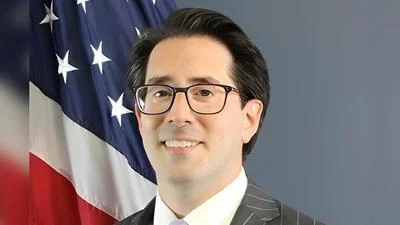The U.S. Department of Energy (DOE) Office of Legacy Management (LM) completed installation of the first full row of anchor blocks to alleviate downhill slipping of two sections of a closed landfill at the Rocky Flats Site. In August 2019, DOE began construction work to install steel anchors, concrete anchor blocks, and subsurface drains to stabilize the Original Landfill. Soil in this steep hillside had been slipping downhill for several years and previous repairs did not provide a long-term fix. The repairs were described in contract record RFLMA CR-2019-02, which was approved by the Colorado Department of Public Health and Environment (CDPHE) on July 12, 2019.
The design to stabilize the landfill consists of a standard engineered ground anchor system that ties deeper bedrock to a reaction block near the surface. This tie-in creates active resistance against larger land movements.
April Tischer, project engineer for the LM Support (LMS) contractor, explained, “The anchor system is similar to a stabilizing anchor system installed in Black Hawk, Colorado, except the Original Landfill system will be buried and eventually indistinguishable from a native hillside."
While the system is considered an industry standard, it is still technically complex with significant work controls.
“We spend a lot of time ensuring each anchor is installed to design specification and the surrounding earthwork is appropriately executed," said Tischer. “We have skilled, experienced people on site, and the attention our designers and construction crew provide to ensure a successful project is commendable."
The top east-side anchor row contains 22 concrete blocks with anchors installed through the block center. The top west-side anchor row contains 37 blocks and anchors. Each anchor extends 39 feet into bedrock, with bedrock depths varying between 20 to 60 feet below the ground surface. Total anchor lengths vary from 60 to 130 feet long.
Prior to installation of the first row of anchors, DOE installed two test anchors on outer edges of the targeted construction area and verified each anchor’s angle, tension, stability, and other factors to meet design specifications.
Subsurface drains will be connected from the top row to lower rows as work moves forward, with the entire area covered and revegetated once work is complete.
Worker risk of exposure to radionuclides and volatile organic compounds (VOCs) is considered low. This low risk potential is based on data obtained during the Original Landfill’s closure, recent intrusive work completed during design development and management, and comprehensive risk assessments. On-site safety and radiological protection specialists reinforce industry best practices and screen operating equipment, excavations including drill cuttings, and personal protective equipment for VOCs and radionuclide contaminants. If contaminants are suspected, work is paused to determine the appropriate path forward. Thus far, no additional actions or work controls to address these contaminants have been necessary.
Chris Graves, LMS deputy project manager, has been on-site since before construction started in August and maintains daily operations with safety as the top priority. Working safely is a mindset he believes every professional on site has fully demonstrated.
“Everyone feels accountable for their work," said Graves. “We have a safety-focused brief to start every work day, and everyone has equal voice. We encourage everyone to ask questions or share concerns, which are addressed with equal importance."
Additional project details, including how the Original Landfill was used from 1952 through 1968, were published on the LM Rocky Flats Site web page in September 2019.









